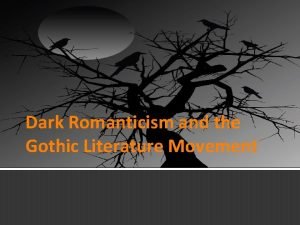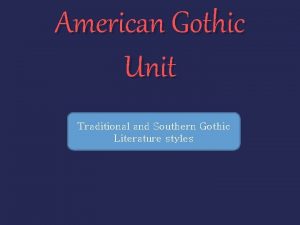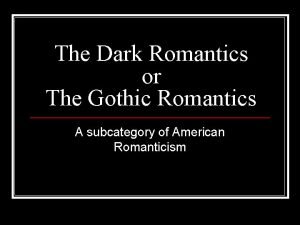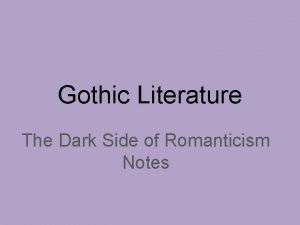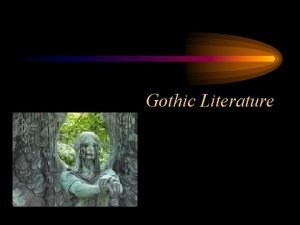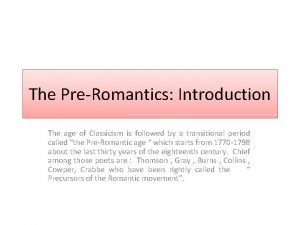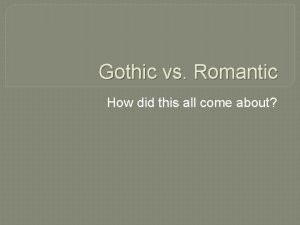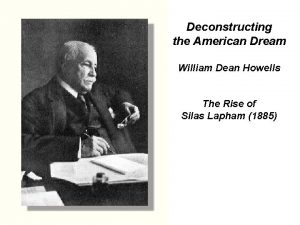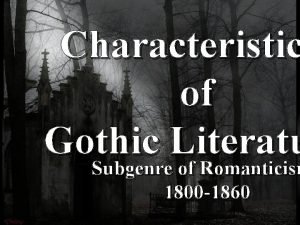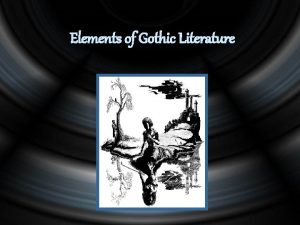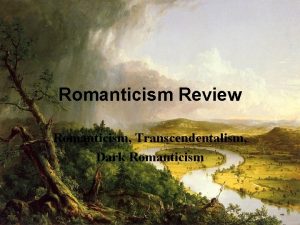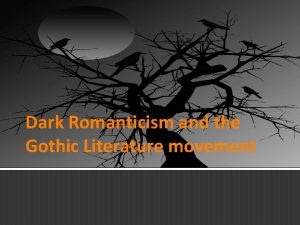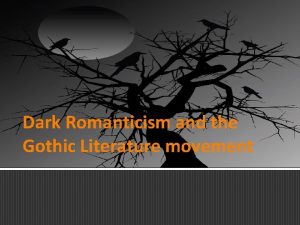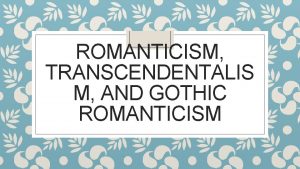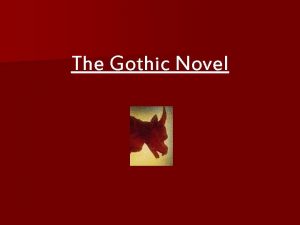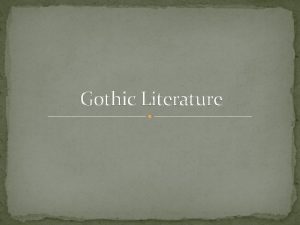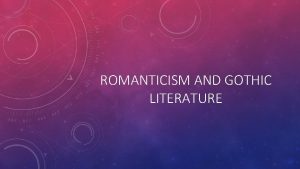Dark Romanticism and the Gothic Literature movement Dark











- Slides: 11

Dark Romanticism and the Gothic Literature movement

Dark Romanticism �A literary subgenre of Romantic Literature that emerged from the transcendental philosophical movement popular in nineteenth-century America. �The Dark Romantics adapted images of anthropomorphized evil in the form of Satan, devils, ghosts, vampires, and ghouls. �Dark Romanticism views nature in a much more sinister light than does Transcendentalism, which sees nature as a divine and universal organic mediator.

Transcendentalism A philosophical movement that developed in the late 1820 s and 1830 s in the eastern United States. It arose as a reaction to or protest against the general state of intellectualism and spirituality at the time. � A core belief of transcendentalism is in the inherent goodness of people and nature. Adherents believe that society and its institutions have corrupted the purity of the individual, and they have faith that people are at their best when truly "self-reliant" and independent. � It taught that divinity pervades all nature and humanity, and its members held progressive views on feminism and communal living.

Characteristics of the Genre �Dark Romantics present individuals as prone to sin and self destruction, not as inherently possessing divinity and wisdom. �The natural world is dark, decaying, and mysterious; when it does reveal truth to man, its revelations are evil and hellish. �Dark Romanticism frequently show individuals failing in their attempts to make changes for the better.

Themes of Dark Romanticism �A collection of works concentrating upon themes of horror, tragedy, the macabre and the supernatural. �The success of this movement also relies on the fact that the human psyche is attracted in a subtle way to the fear, pain and tragedy �It has lead to the birth of the Gothic style and has greatly influenced music and art.

Gothic Literary Movement �Works of the genre commonly aim to inspire terror, including through accounts of the macabre and supernatural, haunted structures, and the search for identity �Gothic fiction is more about sheer terror than Dark Romanticism's themes of dark mystery and skepticism regarding man �Skeptics find Gothic Literature melodramatic and predictable

Edgar Allen Poe �After his mom died when he was 2, he was adopted by a successful merchant and his wife �After taking up drinking and having to quit university, he joined the army �He eventually lived in New York, became a newspaper and magazine editor, and began publishing writing �His personal life was plagued with tragedy and he died suddenly of an unexplained illness on October 7, 1849

Herman Melville �Raised in a prominent New York family until his father’s death �At age 12 he was attempting to support his family with odd jobs �His adventures as a seaman inspired him to write �Works: Moby Dick, Bartleby the Scrivener

Washington Irving � Author Washington Irving was born in New York City in 1783. � The youngest of 11 children of Scottish-English immigrant parents William Sr. and Sarah, he was named after George Washington, the hero of the just-completed American Revolution, and attended the presidential inauguration of his namesake in 1789. � Works: "Rip Van Winkle" and "The Legend of Sleepy Hollow, " as well as for such biographical works as A History of the Life and Voyages of Christopher Columbus.

Nathanial Hawthorne �Born in Salem, Massachusetts to a family with a long New England history �Changed his name from Hathorne to Hawthorne to separate himself from the legacy of judge Hathorne (witch trials) �Works: The Scarlet Letter, “The Minister’s Black Veil, ” “Young Goodman Brown”

Themes and Subjects �His themes often center on the inherent evil and sin of humanity, and his works often have moral messages and deep psychological complexity. �Many of his tales and novels focus on a type of historical fiction, though Hawthorne's depiction of the past is used only as a vehicle to express themes of ancestral sin, guilt and retribution.
 Gothic dark romanticism
Gothic dark romanticism Romantic vs gothic
Romantic vs gothic Southern gothic poems
Southern gothic poems Dark romantics
Dark romantics The dark side of romanticism
The dark side of romanticism Gothic literature vs romanticism
Gothic literature vs romanticism Nathaniel hawthorne contribution to american literature
Nathaniel hawthorne contribution to american literature Pre romantic age
Pre romantic age The romanticism (1795 — 1835) what is romanticism
The romanticism (1795 — 1835) what is romanticism Gothic vs romanticism
Gothic vs romanticism William dean howells editha summary
William dean howells editha summary Gothic vs romantic literature
Gothic vs romantic literature
